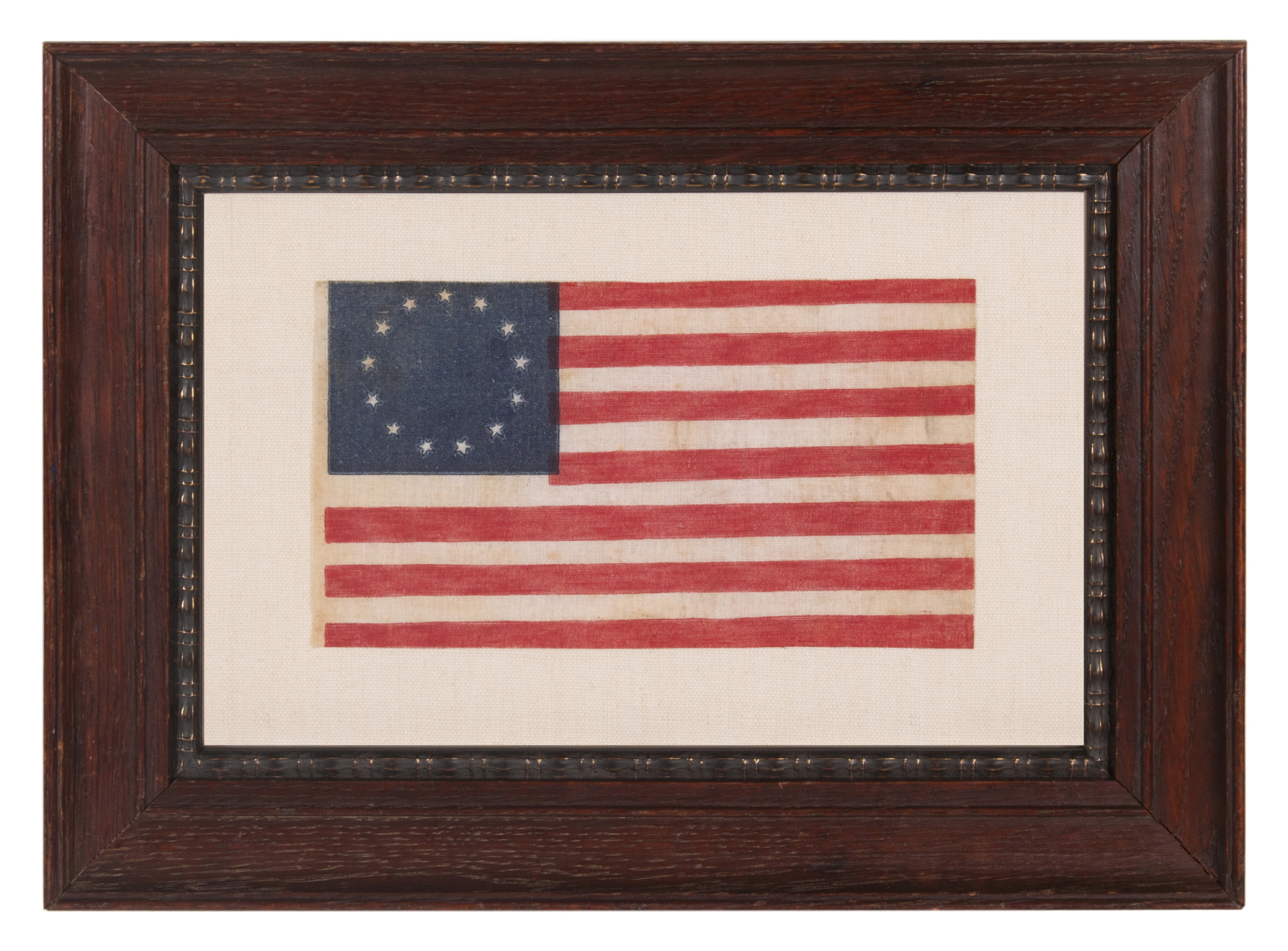
| |
13 STAR ANTIQUE AMERICAN PARADE FLAG, OF THE TYPE ISSUED TO SUPPORTERS OF THE BETSY ROSS HOUSE IN ITS INFANCY AS A MUSEUM, ONE OF THE FIRST PRINTED FLAGS PRODUCED IN THIS DESIGN, circa 1898 – 1915 |
|
| Available: |
Sold |
| Frame Size (H x L): |
9.25" x 12.25" |
| Flag Size (H x L): |
4" x 7" |
|
| Description....: |
|
13 star American parade flag, printed on coarse, glazed, cotton. The stars are arranged in the circular wreath configuration attributed to Betsy Ross. This is the very first, datable, printed variety produced in this star pattern. Made sometime between the opening of the Betsy Ross House as a historic property and museum, in 1898, through 1915, this style was issued with a small calendar, gifted to donors in return for a donation of 10 cents.
Flags in the Betsy Ross design are widely admired, due to the longstanding popularity of the Ross family myth. While many Americans were taught in grammar school that it was her that made and designed our first flag, and that the stars appeared in this fashion, there is unfortunately no way to prove the claim. No colonial examples have survived with this pattern of stars. In fact, I have encountered just a couple of examples of Betsy Ross pattern flags that I can confidently date prior to the 1890's.
One of the interesting misconceptions about 13 star flags is that the Betsy Ross pattern, even if not the original design, must have been common in early America. Logic would suggest this, given the frequency with which it appears in modern times, but this isn’t actually the case. In fact, the pattern is seldom encountered anywhere until much later.
Research conducted by the National Museum of American History notes that the story of Betsy Ross making the very first American flag for General George Washington, in the company of George Ross and Robert Morris, entered into American consciousness about the time of the 1876 centennial. The tale was immensely popular among an American public eager for stories about the Revolution and its heroes. The first documentation of it appeared shortly beforehand, in 1870, in a paper written by Betsy’s grandson, William Canby, for the Pennsylvania Historical Society. At the time, Canby made no mention of how the flag was designed, save for the fact that it had 5-pointed stars, per his grandmother’s suggestion. Because no earlier documentation supports the story, most flag scholars feel it was a grand hoax, fabricated by Canby for his own interests. Nothing survives in the collective writings of the three men, for example, nor in records of their words and deeds, which are fairly extensive. As with most things, reality is perhaps somewhere in the middle ground, with some of the details based on fact and some on fiction, made up, misinterpreted, or imagined from family accounts.
The first time that a star configuration actually gets attached to the Ross story appears to have occurred during the last decade of the 19th century. In 1892, Charles Weisgerber painted a nine-by-twelve-foot rendition of the fabled meeting between Betsy and George Washington, in which there is a flag with a circular wreath. Shortly afterwards, in 1898, Betsy’s granddaughter and great-granddaughter began to make flags in the East Wing of Independence Hall in Philadelphia, selling them to tourists while disseminating the family folk tale. In that same year, Weisgerber and a “group of concerned citizens” sought to preserve Betsy’s former Philadelphia residence at 239 Arch Street, where she lived at the time the flag would have been sewed. Weisgerber moved his family into the house and immediately opened to the public the room in which Betsy was said to have worked her magic. Memberships were sold to fund renovations and donors received the small calendar, to which the type of flag that is the subject of this narrative, was affixed. The effects of these events caused the Ross legend to stick and the story, with the corresponding flag design, has appeared ever since in more places than one could ever hope to count.
Mounting: The flag was mounted and framed within our own conservation department, which is led by expert staff. We take great care in the mounting and preservation of flags and have framed thousands of examples.
The flag has been hand-stitched to 100% hemp fabric. The mount was placed in an acid-washed oak frame that dates to the same period as the flag. Spacers keep the textile away from the glazing, which is U.V. protective glass.
Condition: There is some misprinting, though this adds more to the character of the flag than it detracts. There is minor to modest soiling throughout. Text that likely appeared in an extended white area along the hoist was trimmed away at some point, by a former owner. |
|
|
|
| Collector Level: |
Beginners and Holiday Gift Giving |
|
| Flag Type: |
Parade flag |
|
| Star Count: |
13 |
|
| Earliest Date of Origin: |
1898 |
|
| Latest Date of Origin: |
1915 |
|
| State/Affiliation: |
13 Original Colonies |
|
| War Association: |
1898 Spanish American War |
|
| Price: |
SOLD |
|
| |
Views: 1347 |
|
|
|

